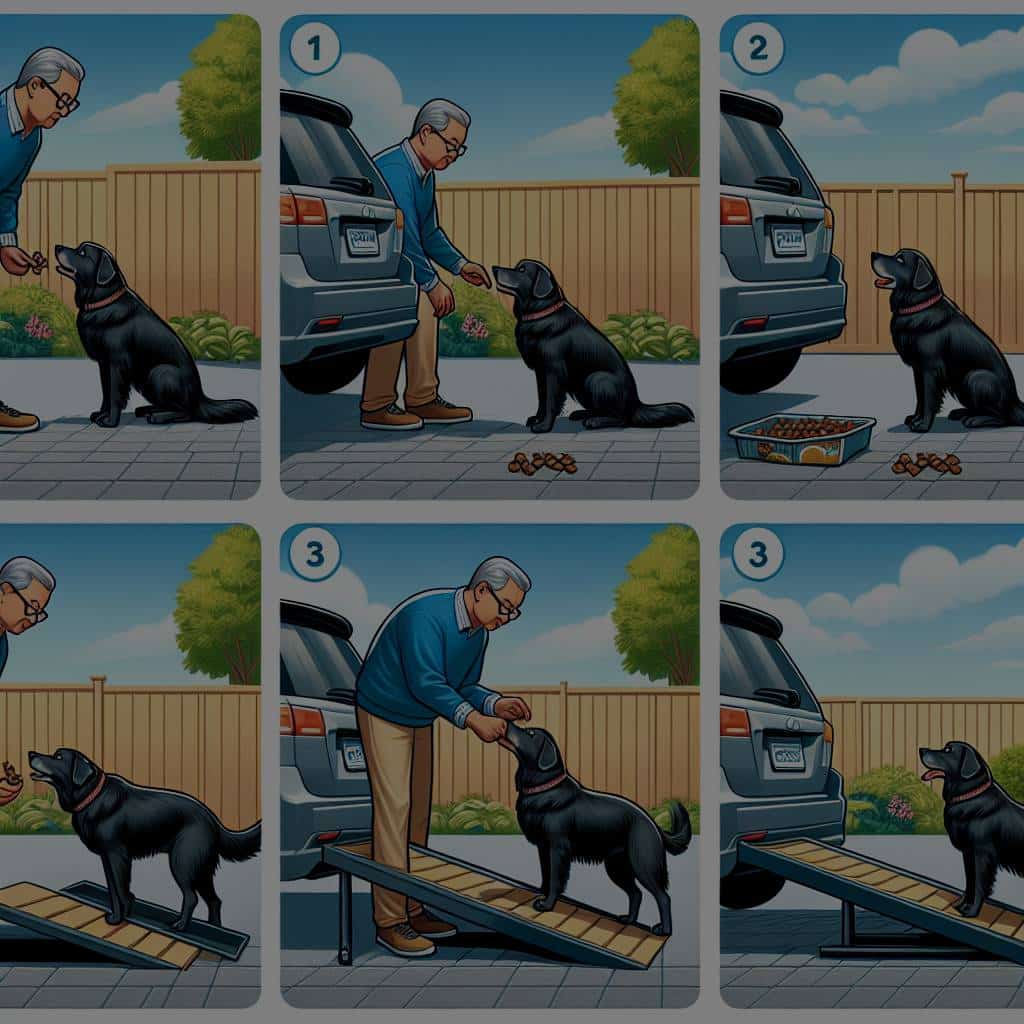How to Train an Older Dog to Use a Ramp for Entering and Exiting Vehicles?

Do you often take your four-legged companion along for a ride but are concerned about their safety while getting in and out of the vehicle? As our dogs age, tasks like jumping into a car or SUV may become a challenge due to health issues such as arthritis. A solution to this problem lies in training your pet to use a dog ramp. A well-designed ramp with the right height and gentle slope will not only make it easy for your dog to enter and exit the vehicle but also help prevent injuries. However, introducing your pet to a new object and training them to use it may require time and patience. In this article, we’ll guide you through the process of teaching your older dog to use a ramp comfortably and safely.
Choosing the Best Ramp for Your Dog
Before you start the training process, it’s essential to choose the right ramp that suits your dog’s needs and can be used with your vehicle. The best dog ramps are typically ones that are sturdy, have a non-slip surface, and can support your dog’s weight.
Cela peut vous intéresser : What’s the Most Effective Way to Clean and Disinfect a Pet Bird’s Cage and Toys?
For large dogs that weigh over 100 pounds, you need to invest in a robust ramp that can handle the weight without wobbling. These ramps are usually made of durable materials like heavy-duty plastic or metal. In contrast, for smaller dogs, a lightweight ramp made of fabric or foam could suffice.
The best ramps also have non-slip surface, ensuring your pet’s safety even during wet conditions. Moreover, the incline should be gentle enough for older dogs to walk up and down without straining their joints.
A lire également : How Can You Prevent Your Cat from Overgrooming Due to Anxiety?
Lastly, the ramp must be compatible with your vehicle. For example, SUV ramps are often longer and wider to accommodate the vehicle’s height.
Introducing Your Dog to the Ramp
After you’ve chosen the ramp, the next step is introducing your dog to it. The process should be gradual and positive to ensure that your pet doesn’t develop a fear of the new object.
Initially, you can place the ramp flat on the ground and let your dog explore it. You can encourage them to walk over it by using treats or their favorite toy. This will help to create a positive association with the ramp.
Once your dog is comfortable walking on the ramp, you can increase the incline gradually. It’s important to be patient during this process and not rush your pet. Their pace will depend on their age, health status, and temperament.
Training Your Dog to Use the Ramp
Now that your dog is familiar with the ramp, you can begin the training process. This involves teaching them to walk up and down the ramp, first with your assistance and then independently.
Start by guiding your dog up the ramp with a leash. Stand next to them and use a soft, encouraging voice to coax them up. If your dog seems unsure or scared, don’t force them. Instead, use positive reinforcement like treats or praises to motivate them.
Once your dog has mastered walking up the ramp, teach them to navigate down it. This step can be a bit more challenging, as going downhill can seem intimidating to some dogs. However, with patience and positive reinforcement, they’ll soon get the hang of it.
Using the Ramp with Your Vehicle
After your dog has become comfortable using the ramp on flat ground and at different inclines, it’s time to introduce the ramp in conjunction with your vehicle.
Start with your vehicle at a lower height, such as an empty parking lot or driveway. Attach the ramp securely to your vehicle, ensuring that it doesn’t slip or move when your dog uses it. Guide your dog up and down the ramp several times until they seem comfortable.
Gradually, you can increase the height by parking on a ramp or incline. Always keep the training sessions short and positive, and remember to reward your dog for their progress.
Making the Ramp a Part of Your Routine
The final step in training your dog to use a ramp is making it a part of your routine. This means using the ramp every time your dog needs to enter or exit the vehicle.
Consistency is key here. If you’re inconsistent, your dog may get confused and revert to their old habits of jumping in and out of the car. Therefore, even if it’s just a short trip, always use the ramp.
With these steps, training your older dog to use a car ramp can be a smooth and stress-free process. Remember, patience is vital during this training – don’t rush your dog, and always end each training session on a positive note. By doing so, you’re not just teaching your dog a new skill, but also ensuring their safety and comfort during car rides.
In conclusion, a dog ramp is a great tool to help your aging pet navigate their way into and out of your vehicle. With the right ramp and training, car rides can continue to be a joyful experience for both you and your dog.
Selecting the Right Dog Ramp for Your Pet and Vehicle
Selecting the optimal dog ramp is the first step towards training your older dog to enter and exit the vehicle smoothly. This process essentially involves assessing your dog’s needs and the compatibility of the ramp with your vehicle.
Always prioritize the safety and comfort of your pet. Select a sturdy ramp that can support your pet’s weight. Large dogs, especially those weighing over 100 pounds, require a robust ramp made from heavy-duty plastic or metal. On the other hand, a fabric or foam ramp can be sufficient for smaller dogs.
The non-slip surface of the ramp is critical to prevent your pet from slipping, particularly during wet conditions. Always ensure the incline is gentle enough to prevent exertion on your dog’s joints.
In terms of height and width, keep in mind your vehicle’s specifications. SUVs, for instance, necessitate ramps that are longer and wider. A foldable dog ramp can be a great option for easy storage.
A Step-by-Step Guide to Training Your Dog to Use the Ramp
The process of training your dog to use the ramp involves familiarization, training, and consistent use. It requires patience, positive reinforcement, and gradual progression in terms of the ramp’s incline and use with your vehicle.
Begin by placing the ramp flat on the ground, allowing your dog to explore it. Encourage their interaction with the ramp using treats or their favorite toy, creating a positive association with the ramp.
Once your dog is comfortable walking over it, you can gradually increase the incline. Ensure you match the pace to your dog’s comfort, based on their age, health, and temperament.
Next, guide your dog up and down the ramp, first with your assistance and then independently. Use a leash, encouraging voice, and treats or praises for positive reinforcement. If your dog seems hesitant, be patient and don’t force them.
Introduce the ramp with your vehicle, starting at a lower height. It’s important to ensure the ramp is securely attached to your vehicle. Gradually increase the height as your dog becomes more comfortable.
Finally, make the ramp a part of your routine, using it every time your dog enters or exits the vehicle. Consistency is key to prevent your dog from reverting to their old habits.
Conclusion
A dog ramp proves to be an excellent tool to ensure the safety and comfort of your aging pet during car rides. Selecting the right ramp, introducing it gradually, and practicing consistently can make car rides a happy ride for both you and your pet. With a bit of patience, you can seamlessly train your older dog to use a car ramp, preventing unnecessary strain on their joints and making each car ride a joyous one.
